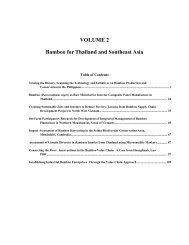WBC-VIII-Vol.4 – Resources – Forestry, Plantations and ... - BambuSC
WBC-VIII-Vol.4 – Resources – Forestry, Plantations and ... - BambuSC
WBC-VIII-Vol.4 – Resources – Forestry, Plantations and ... - BambuSC
Create successful ePaper yourself
Turn your PDF publications into a flip-book with our unique Google optimized e-Paper software.
For bamboo species, models for predicting culm height from diameter are not often used (Fu 2001; Watanabe<br />
<strong>and</strong> Oohata 1980). For guadua, a simple model has been used to predict culm length (L) from the perimeter at<br />
breast height (C), including a constant (K), which has been determined empirically (Arbelaez 1996, Cruz 1994).<br />
For volume, some studies have related it with biomass estimation (Reid et al. 2004) or with physical <strong>and</strong><br />
mechanical properties of culms (Jamaludin et al. 2000)<br />
Camargo (2006) estimated the relationship between culm diameter, culm length <strong>and</strong> culm volume by using<br />
linear <strong>and</strong> non-linear regressions. These models were used in regression analyses of culm length, apparent <strong>and</strong><br />
net culm volumes being the dependent variables. The equations developed for tree mensuration are useful for<br />
predicting total culm length <strong>and</strong> culm volume using a number of independent variables. These models can be<br />
used with an adequate precision for estimating both variables. For estimating culm length the modified model of<br />
Cox, which includes the st<strong>and</strong> variable square mean diameter was the best. (R 2 adj=0.49, RMSE=2.5). For<br />
apparent culm volume the allometric model was the best among the models tested (R 2 adj=0.89, RMSE=0.005). A<br />
linear regression model was also fitted to estimate net culm volume from apparent culm volume (R 2 adj = 0.94,<br />
RMSE = 0.001).<br />
With reference to st<strong>and</strong> variables, Camargo (2006) <strong>and</strong> Morales (2004) have defined that the most representative<br />
st<strong>and</strong> variable for gathering in guadua inventories is the total number of culms per hectare. This variable defines<br />
the potential productivity of the guadua st<strong>and</strong>s <strong>and</strong> also is the base to determine harvest. Other variables as basal<br />
area <strong>and</strong> total volume moreover could provide important information on guadua st<strong>and</strong>s. However harvest plans,<br />
traditionally have been defined with regard to number of culms to be harvested (Camargo et al. 2008; Camargo<br />
2006).<br />
Studies on plot design conducted within guadua st<strong>and</strong>s permit to conclude that circular plots provide the highest<br />
precision in inventories (Rijal 2006). However, plots with this shape are highly dem<strong>and</strong> of sample effort <strong>and</strong><br />
cost of inventory could increase. In this sense, rectangular <strong>and</strong> square plots can be more easily established.<br />
Among both plots, the rectangular have showed the lowest st<strong>and</strong>ard error <strong>and</strong> consequently the highest<br />
precision. However, plots should be arranged with the longer side against the slope. In relation to plot size, Rijal<br />
(2006) suggest that plots between 50 m 2 y 200 m 2 have the best precision. These results are also consistent with<br />
Camargo (2006) <strong>and</strong> Schumacher (2006) who tested the precision of different plot sizes within natural guadua<br />
st<strong>and</strong>s.<br />
Silviculture of natural guadua st<strong>and</strong>s<br />
Traditionally within natural guadua st<strong>and</strong>s most of the practices are associated to the harvest. These practices are<br />
focused in improving the access to st<strong>and</strong> <strong>and</strong> include pruning (elimination of lateral branches which are usually<br />
thorny) <strong>and</strong> removal of those culms which have reached the last stage of maturity <strong>and</strong> during the inventories are<br />
found dry, broken or dead. These culms are removed especially within st<strong>and</strong>s with high culms density (over<br />
6000 culms per ha). Only in few cases fertilisation is done. It is due to fact that there is scarce information on<br />
benefits of this practice <strong>and</strong> because of productivity of st<strong>and</strong>s even without fertilisation is adequate, in terms of<br />
the amount of culms dem<strong>and</strong>ed in the market.<br />
<strong>VIII</strong> World Bamboo Congress Proceedings Vol 4-38




